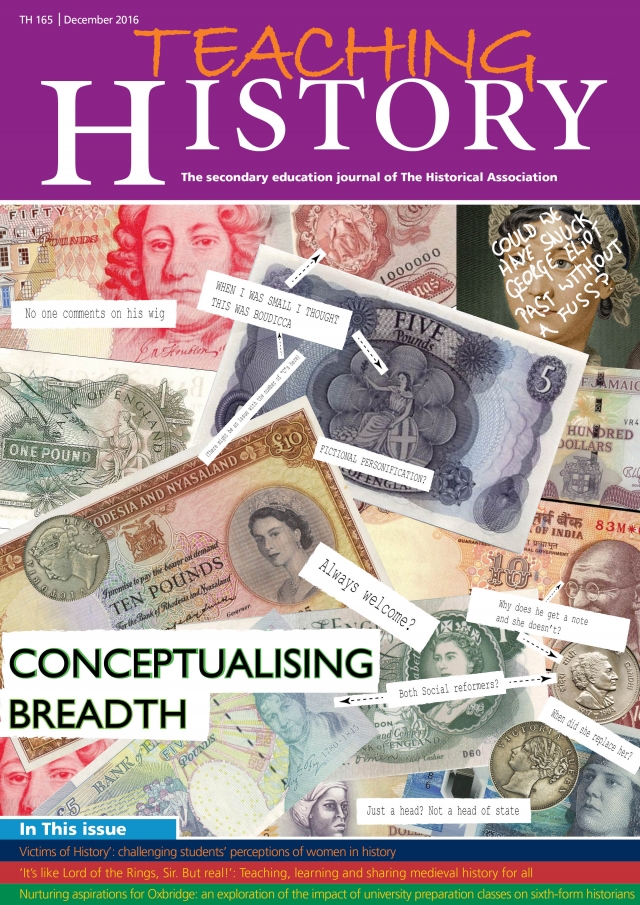Teaching History 165: Out now
Journal

Conceptualising breadth
It might seem foolish, at a time when history teachers in England, facing new public examinations at every level, are most anxiously seeking to determine exactly what the specifications require of their students, to urge them to think afresh about curriculum breadth. Yet it isprecisely at this moment, as new schemes of work are constructed and refined in light of initial experience, that there may be most scope to adapt provision to encompass a wider vision of the richness and diversity of our shared past.
A concern for greater breadth obviously underpins the recent changes to national requirements. While A-level specifications now demand a minimum span of 200 years between the earliest and latest periods chosen, the national criteria for GCSE have specified not only a wide chronological range for the curriculum as a whole (which must include Medieval, Early Modern and Modern history) but also greater breadth in terms of the timescales on which students operate (zooming in from thematic studies of a thousand years to tightly-focused depth studies) and in relation to the geographical focus of their work. For the first time ever, detailed study of a particular locality has been mandated alongside the more conventional requirement to include both national and European or wider world history.
These regulations are obviously based on particular conceptions of curriculum breadth; conceptions which – despite the extensive challenges that they have created – most HA members have welcomed. But breadth may be conceptualised in other ways too. Some focus attention on the range of human experiences encompassed within the curriculum as it is taught: who exactly is included within the frame of teachers’ schemes of work? Some focus attention on the range inherent in the questions that are posed: how big is the frame of reference within which students are encouraged to think? And some prompt careful consideration of the extent to which all young people feel included in the study of the past: how can teachers make this extraordinarily rich and inevitably complex subject accessible and meaningful to the full range of learners in their classrooms?
All of these questions are tackled across the range of articles in this edition. Chris Eldridge, aware of the impetus given to medieval history by its inclusion within GCSE, makes a powerful argument for devoting time to it at A-level as well. While he recognises how daunting the period might appear, he is driven by a concern to demonstrate not only its relevance in relation to understanding the modern world, but also its accessibility to both teachers and students.
The questions of who is included within our historical frame and how their experiences are considered are addressed by Bridget Lockyer and Abigail Tazzyman, with a focus on women’s history. While they seek to improve on the disconnected way in which women’s experiences are often addressed in stand-alone modules, they also recognise that ‘mainstreaming’ women’s history risks losing sight of women’s unique experiences and contribution. Drawing on a series of workshops for Year 12 students, they offer several ways of thinking about the past lives of both women and men, ensuring they are not automatically presented in binary opposition and that the diversity of experiences across genders is explored.
Nick Dennis is also concerned to offer readers practical strategies for broadening their curriculum, in this case to ensure the inclusion of more black history. While the breadth for which he calls is intended to help students see beyond conventional narratives, he fully recognises the constraints within which teachers work and therefore offers fascinating individual examples at the heart of familiar topics routinely taught within examination syllabuses. It is by ‘deepening’ their own existing knowledge in specific ways that teachers can enrich students’ vision of the past and the rigour of their historical thinking.
Lucy Hemsley offers a rather more challenging message, concluding that it may be important for teachers to look beyond the constraints of exam specifications. Prompted by a concern to encourage more history students from her comprehensive school to apply to elite universities, her analysis of the explicit requirements of both Oxford and Cambridge made her question whether A-level exam specifications alone promoted a sufficiently challenging or engaging vision of high-level historical thinking. Her experiences of running a series of university preparation classes, essentially focused on getting students to think bigger – broadening their experience, promoting their independence and enriching their sense of historical perspective – led her to think afresh about the kind of big picture frameworks with which she was equipping students at all curriculum stages.
Finally, the breadth of the editors’ vision is perhaps encapsulated in the inclusion of an article by an English teacher, Dianne Excell, who found herself teaching history as part of a cross-phase, cross-curricular collaborative project between schools in Bradford and Peshawar in Pakistan. While few teachers may enjoy the opportunities for international collaboration afforded by engagement in a British Council ‘Connecting Classrooms’ project, there is much that history teachers might learn from her experiences about the impact of collaborating with other departments in the pursuit of shared objectives for students’ learning and the value of giving young people time to explore both the history of their own locality and the heritage of the families represented within their school community.

